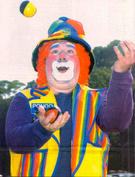

Pongo the Clown (also known as Paul Mordoff) performed on the Fourth of July at the Shorehaven Country Club in Norwalk. He is teaching classes on clowning for the Wilton Arts Council this summer. An example of one of Pongo’s balloon sculptures is seen below. – Bryan Haeffele photo
Clowning Around with Pongo
by: BEN SANDERS
The Wilton Arts Council has officially sent in the clowns. Or at least, one clown: Norwalk’s Pongo the Clown (a.k.a. Paul Mordoff) who will be teaching a selection of clowning classes this summer for kids entering grades one through eight.
Mr. Mordoff, whose experience in clowning goes back 20 years, has been performing as Pongo since 1996. He’ll be offering four different classes this summer, all of them being taught at the United Covenant Church on Westport Road.
“The classes are going to be geared for the different ages:” said Mr. Mordoff in an interview last week. For the youngest kids, grades one through four, he will be teaching Creativity for the Creative Child. His students will use props, storytelling and creative play to explore their theatrical sides, he said.
“It’s a chance for kids to really have fun and use their imaginations” said Mr. Mordoff. There will be a similar class for older students, called Finding the Clown Inside. This class will offer a lot of practice in improvisation and teach basic clown skills as the students work through skits and scenes. There will be two classes on the more technical skills of clowning, juggling and balloon sculpture, for students entering grades five through eight. “The juggling is going to be a lot of fun” said Mr. Mordoff. He plans to teach the children the basics of three-ball juggling. As they get the hang of that, he hopes to move on to more advanced tricks like passing balls back and forth or stealing themfrom other jugglers. “I’m going to tell them all to practice 15 minutes a day,” said Mr. Mordoff. “If they do, they’ll all be juggling by the end of the class.”
Students in the balloon-making class will learn to make a number of different animals, as well as flowers and hats. One thingthey won’t have to do is blow up the animals the old-fashioned way. Mr. Mordoff uses a pump when he performs, and he teaches his students to do the same. First off, the balloons are very difficult to blow up and could pose a choking hazard for his younger students. Additionally, the powder
inside the balloons that helps prevent premature popping can cause lung problems in the long haul. While it wouldn’t cause problems for hisstudents in a two-week class, it’s something that someone who blows up 1,200 balloons a month (like Mr. Mordoff) has to think about, he said.
Mr. Mordoff has quite a repertoire of balloon sculptures at his disposal. He can twist the long, snake-type balloons into anything from a flower to a dog to a penguin. His most complex is probably the Tyrannosaurus rex. “That’s a really popular one,” he said. “It can take four or five balloons.”
Mr. Mordoff said he picks up new designs from a variety of sources: Videos, Web sites and at clown conventions, for example. Depending on the complexity of a new design, it can take him a few hours to master a new design.
Each class will be offered in three two-week sessions, between July 14 and Aug. 22.
Beginnings
Mr. Mordoff got his start in clowning back in 1991 working for a company that offered “Gorilla-grams” and other costumed performers for birthday parties and provided singing telegrams. He started dressing up as a clown there, and found he liked it better than the heavier costumes of the other characters. It let him have a lot more freedom of movement, and freedom to improvise.
A theater major in college, Mr. Mordoff has also worked as an actor, with small parts in films, commercials and plays. “It’s fun to see yourself on the screen,” he said. “But at the end of the day you realize you don’t get paid that much.” Mr. Mordoff has been a performer in one form or another since his childhood. He was in touring, acting and choir companies in high school. He has also ran a couple of touring theater companies.
His last day job was for a company that recruited foreign workers to come to the US as camp counselors. He worked on the crisis team there, traveling all over the world to meet clients’ needs. He left that two years ago, to concentrate on his career as Pongo. “Eventually I decided I had to make my life easier and go full time with the clowning,” said Mr. Mordoff.
Full-time Clown
These days, he gets 4 to 10 jobs a week. He’ll do up to six or seven on the weekends, plus one to five during the week. “I’m getting a decent reputation,” he said. He gets a lot of
repeat business and a lot of referrals.
He also follows up on every gig, to make sure the customer was satisfied with his performance.
Mr. Mordoff sends the customers letters asking them whether he met their expectations and which parts of the performance they liked best. He said he gets responses from 80% of his clientele, and that the responses have all been good. For more information on booking Pongo the Clown: 866-0543 or
http://www.pongotheclown.com/experience.html
Being Pongo
Once the make-up goes on, Mr. Mordoff becomes Pongo the Clown, inside and out. “Somehow, I become funny. I’m not sure how that works,” he said. “I do become a different character. Absolutely. It’s not me anymore”
Mr. Mordoff has a set routine of 15 to 20 bits that he uses for a typical birthday party, but he jumps
around between them depending on the mood of the room. For instance, if the audience is getting restless, he’ll involve them in a high-energy game like Pongo Says.
He has his set comedy pieces, plus he improvises and plays to the crowd, working with the kids as he goes. “There’s something so special when you get belly-laughs from 15 kids” he said.
He works some magic and some juggling into his shows. “The magic I do is more comedy magic” said Mr. Mordoff. “You think you’re going to make a chocolate cake, and you end up with a rubber chicken”
Miracles
The struggle is part of the fun when hegets to juggling. He has the kids talk him through the process, feigning an inability to keep the balls in the air. “Pongo miraculously learns to juggle at every party,” he said. It’s that struggle that the kids really enjoy, he said. “Part of the humor of clowns is that the kids are moreintelligent than you are.”
The hardest part of his job can becontrolling a room of energetic children, while still staying in character
and staying funny. If parents aren’t helping him, that can be difficult. He said difficult parties are few and far between, but they can be quitetaxing. Kids also confuse clowns with cartoon characters every now and then, thinking that they can take the sort of punishment a TV charactercan. He’s had children jump on his clown shoes, kick him in the shins and even punch him in the face.
His act is also a strain on his body. “I’m a very physical clown, a high energy clown:’ he said. By the end of his third or fourth show in a given day, he’s pretty much exhausted.
Humor and Healing
The classes in Wilton won’t be Mr. Mordoff’s first time teaching clowning. He has been involved with
Health and Humor Associates (HAHA) at Stamford Hospital for five years, and was elected president of the organization this year. Depression can slow people’s recovery, he said, but HAHA helps to stave that off. Mr. Mordoff trains people in clown skills so they can entertain patients and visits patients himself.
When he’s not performing, Mr. Mordoff is spending time with his two sons, ages 7 and 12. The two boys are somewhatsplit on their father’s clowning career. “My younger one loves it,” he] said. “My older one is like ‘Get that sign off the car!” Mr. Mordoff’s oldcar had a big “Pongo the Clown” sign on it, but he bowed to his son’s wishes and got rid of that. “It’s boring’ ” he said. “But I’ve got to be a father, too.”




